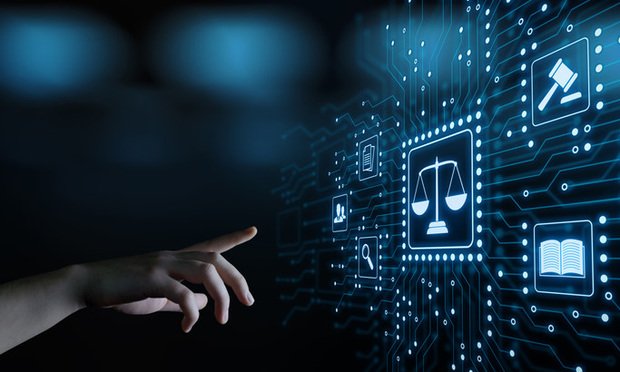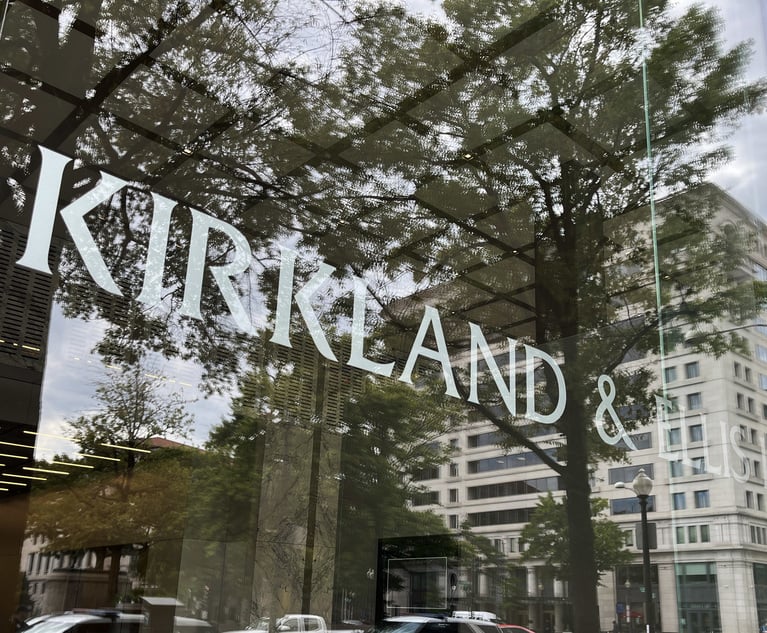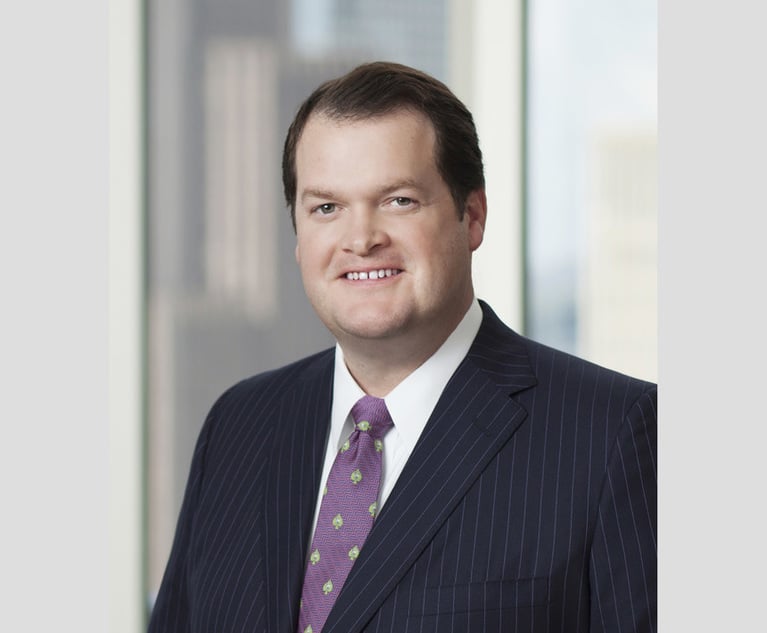#MeToo, IP Issues Among Top Litigation Trends in 2019: Crowell Report
For a change, the Eastern District of Texas is not leading the nation in patent filings after about a dozen years on top.
January 15, 2019 at 03:04 PM
4 minute read
The original version of this story was published on Corporate Counsel

In-house legal departments are facing growing challenges in 2019 from the #MeToo movement and radically evolving intellectual property landscape. But the new year also will see an increased use of technology as an aid in litigation.
At least that's the outlook from Crowell & Moring's annual report on litigation trends, Litigation Forecast 2019: What Corporate Counsel Need to Know for the Coming Year.
The report identifies about a dozen areas that should be front and center in the minds of general counsel, chief among them labor and employment, IP and the use of technology in litigation case strategy, said Mark Klapow, a partner in Crowell's litigation group in Washington, who created and edited the 35-page report.
Other areas included in the report are antitrust, environment, government contracts, torts, white collar, privacy and cybersecurity, corporate, e-discovery, health care and trade.
On the IP front, the U.S. District Court for the Eastern District of Texas did not lead in the number of patent filings last year, ceding that top position for the first time in about a dozen years to the U.S. District Court for the District of Delaware—an indication of weakened IP rights, Klapow said.
Employment is a hot area, Klapow said, because #MeToo has spawned state and municipal legislation hat targets confidentiality and settlement agreements as well as “other perceived tools for repeat offenders to hide behind,” he said.
“You read about these instances where someone has been accused a half-dozen times and is just hiding behind these [nondisclosure agreements] and settling, and we're seeing more laws that target that practice,” said Klapow, adding federal lawmakers also may seek to legislate this practice.
States and municipalities also have taken action to prohibit an employer from asking a prospective employee about his or her current compensation, making “gender pay equity another area where we can expect to see some action,” he added.
The Crowell report also looks at jurisdictional trends such as longest time from filing to termination—the U.S. District Court for the Eastern District of Arkansas with 1,420 days—and the biggest damages award in 2018—the U.S. District Court for the Southern District of New York.
“The pendulum tends to swing away from patent rights, and we're seeing companies adjust their IP strategies and more trade secret filings than we've seen in the past,” Klapow said.
The report's cover story, written by Kent Goss, a Crowell partner and member of the firm's litigation group steering committee in Los Angeles, notes the changing nature of litigation.
“The overall trend today is for companies to take fewer cases to trial, but to take the cases that are more complex and significant to the business all the way because the client needs to take a stand or a case can set precedent for a docket,” according to the article. “This drives costs up, and technologies such as analytics and AI-based automation will be needed to manage those costs.”
In fact, legal departments that aren't already using data analytics to help guide their litigation strategy are behind, Klapow said.
“It's all about understanding how fast the case is going to move, the likelihood of success on a summary judgment motion, to what extent equitable relief is likely,” he said. “For complex litigation, that's mandatory at this point. Everybody should be doing it.”
Another technological trend, Klapow added, is the use of analytics and AI in jury research, which he described as traditionally “a little bit more feel than science.”
But “the analytical tools that are available where courts allow them give you an opportunity to get more insight, in real time, into jurors and their predispositions,” he said. “It's a tool that we all need to look at where it makes sense and where it's allowed.”
This content has been archived. It is available through our partners, LexisNexis® and Bloomberg Law.
To view this content, please continue to their sites.
Not a Lexis Subscriber?
Subscribe Now
Not a Bloomberg Law Subscriber?
Subscribe Now
NOT FOR REPRINT
© 2025 ALM Global, LLC, All Rights Reserved. Request academic re-use from www.copyright.com. All other uses, submit a request to [email protected]. For more information visit Asset & Logo Licensing.
You Might Like
View All
Energy Lawyers Field Client Questions as Trump Issues Executive Orders on Industry Funding, Oversight
6 minute read
Holland & Knight Hires Former Davis Wright Tremaine Managing Partner in Seattle
3 minute read
Kirkland Is Entering a New Market. Will Its Rates Get a Warm Welcome?
5 minute read
Trending Stories
- 1Corporate Litigator Joins BakerHostetler From Fish & Richardson
- 2E-Discovery Provider Casepoint Merges With Government Software Company OPEXUS
- 3How I Made Partner: 'Focus on Being the Best Advocate for Clients,' Says Lauren Reichardt of Cooley
- 4People in the News—Jan. 27, 2025—Barley Snyder
- 5UK Firm Womble Bond to Roll Out AI Tool Across Whole Firm
Who Got The Work
J. Brugh Lower of Gibbons has entered an appearance for industrial equipment supplier Devco Corporation in a pending trademark infringement lawsuit. The suit, accusing the defendant of selling knock-off Graco products, was filed Dec. 18 in New Jersey District Court by Rivkin Radler on behalf of Graco Inc. and Graco Minnesota. The case, assigned to U.S. District Judge Zahid N. Quraishi, is 3:24-cv-11294, Graco Inc. et al v. Devco Corporation.
Who Got The Work
Rebecca Maller-Stein and Kent A. Yalowitz of Arnold & Porter Kaye Scholer have entered their appearances for Hanaco Venture Capital and its executives, Lior Prosor and David Frankel, in a pending securities lawsuit. The action, filed on Dec. 24 in New York Southern District Court by Zell, Aron & Co. on behalf of Goldeneye Advisors, accuses the defendants of negligently and fraudulently managing the plaintiff's $1 million investment. The case, assigned to U.S. District Judge Vernon S. Broderick, is 1:24-cv-09918, Goldeneye Advisors, LLC v. Hanaco Venture Capital, Ltd. et al.
Who Got The Work
Attorneys from A&O Shearman has stepped in as defense counsel for Toronto-Dominion Bank and other defendants in a pending securities class action. The suit, filed Dec. 11 in New York Southern District Court by Bleichmar Fonti & Auld, accuses the defendants of concealing the bank's 'pervasive' deficiencies in regards to its compliance with the Bank Secrecy Act and the quality of its anti-money laundering controls. The case, assigned to U.S. District Judge Arun Subramanian, is 1:24-cv-09445, Gonzalez v. The Toronto-Dominion Bank et al.
Who Got The Work
Crown Castle International, a Pennsylvania company providing shared communications infrastructure, has turned to Luke D. Wolf of Gordon Rees Scully Mansukhani to fend off a pending breach-of-contract lawsuit. The court action, filed Nov. 25 in Michigan Eastern District Court by Hooper Hathaway PC on behalf of The Town Residences LLC, accuses Crown Castle of failing to transfer approximately $30,000 in utility payments from T-Mobile in breach of a roof-top lease and assignment agreement. The case, assigned to U.S. District Judge Susan K. Declercq, is 2:24-cv-13131, The Town Residences LLC v. T-Mobile US, Inc. et al.
Who Got The Work
Wilfred P. Coronato and Daniel M. Schwartz of McCarter & English have stepped in as defense counsel to Electrolux Home Products Inc. in a pending product liability lawsuit. The court action, filed Nov. 26 in New York Eastern District Court by Poulos Lopiccolo PC and Nagel Rice LLP on behalf of David Stern, alleges that the defendant's refrigerators’ drawers and shelving repeatedly break and fall apart within months after purchase. The case, assigned to U.S. District Judge Joan M. Azrack, is 2:24-cv-08204, Stern v. Electrolux Home Products, Inc.
Featured Firms
Law Offices of Gary Martin Hays & Associates, P.C.
(470) 294-1674
Law Offices of Mark E. Salomone
(857) 444-6468
Smith & Hassler
(713) 739-1250






